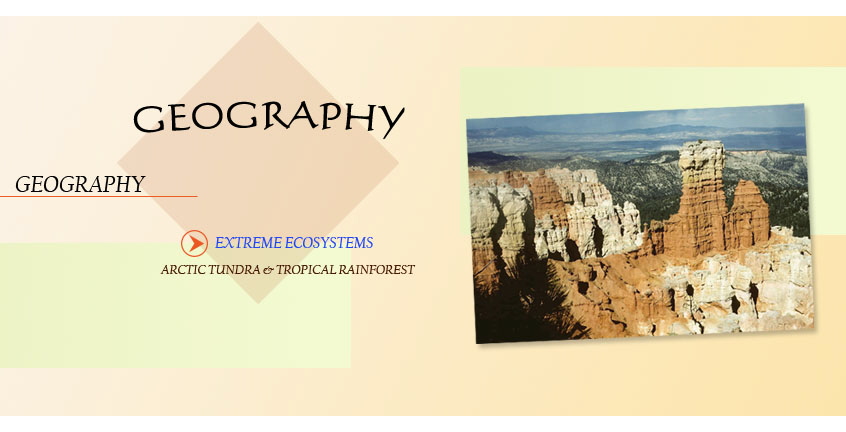|

|
EXTREME ECOSYSTEMS:
Arctic Tundra & Tropical Rainforest
Code D6: (DVD ONLY)
This DVD contains 2 programs
Program 1
ARCTIC TUNDRA
This program explores the tundra; a cold, treeless area and the coldest biome or habitat on earth. The tundra is characterised by very low temperatures, very little precipitation (rain or snow), a short growing season, few nutrients, and low biological diversity. The word tundra comes from the Finnish word tunturia, which means ‘treeless plain.’
Few places in the world could be as unforgiving as the arctic tundra. Yet in this most forbidding of environments a startling array of plant and animal life can be found. Given the weather it is hardly surprising that few animals remain in the tundra during winter. Some specially adapted animals such as the Musk Ox and the Arctic Fox tough out the impossible winter conditions, while the majority, including Caribou and birds migrate south to avoid the worst of winter.
With the coming of spring life returns to the tundra. Migratory animals begin to move north and the ground thaws enough to allow the shrubs, flowers and grasses to germinate for another year. With the melting of the winter snow innumerable lakes are formed across the tundra that soon become home to billions of insects.
The brief summer is a time for raising young and putting on enough reserves to get through the coming winter. This is a time of plenty on the tundra when the sun never sets and the vast plains are filled with animal and bird life.
By August the summer is already turning and those animals that migrate begin their journey south. Some flowers use the last of the summer’s warmth to flower and set seed before the arrival of winter giving animals the last chance to fatten up before the return of cold weather.
Program 2
TROPICAL RAINFOREST
Tropical rainforests are today restricted to relatively small pockets of land clustered around the equator. Yet within these remaining parcels of land is an extraordinarily diverse ecosystem. This diversity is driven by the tropical climate - rain - and lots of it - along with abundant sunshine. This promotes rapid plant growth, which in turn, attracts a stunning variety of animals.
The world’s rainforests can all be divided into four distinct zones, each of which has its own common characteristics.
At the top is the emergent layer where the tallest trees supported by massive buttress roots, break through into the sunlight. Below these giants of the forest is the unbroken canopy of the rainforest - an endless mat of interlocking trees; home to many animals that spend their whole lives solely in the tree tops. Below the canopy, the rainforest takes on a different feel as sunlight is shut out and plants struggle for what little light there is. In the understorey broad leafed plants capture every drop of sunlight, while in clearings young trees race to fill the gap in the canopy. At the bottom is the forest floor, a wet, leaf strewn world primarily inhabited by scavenging mammals, insects, fungi and amphibians. Together these plants and animals break down enormous amounts of organic material enabling the rainforest to survive.
For prices, see our catalogue 
Back to top
|


